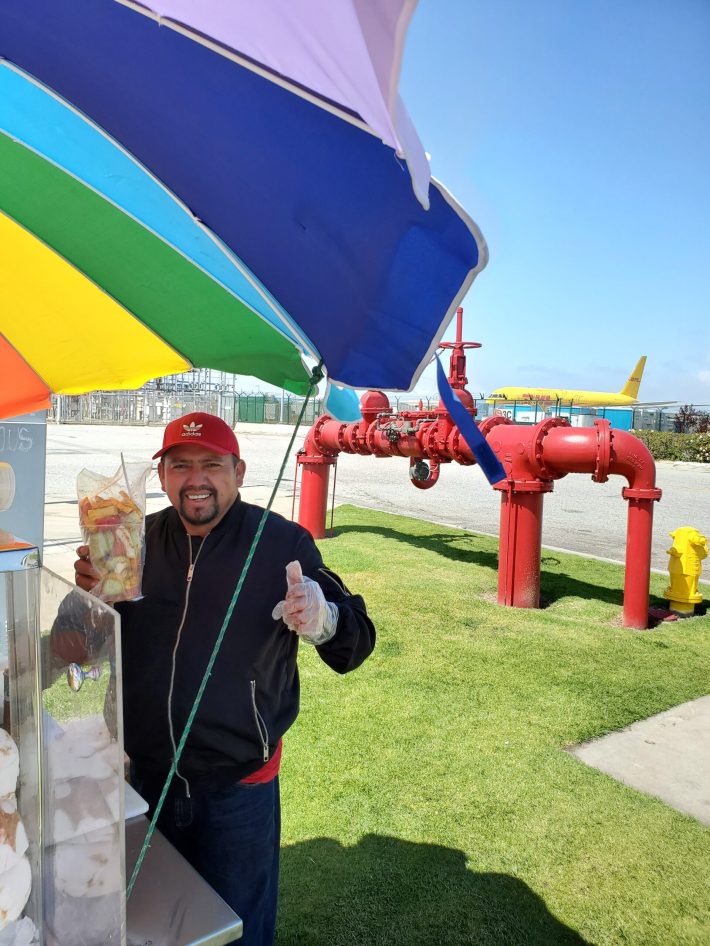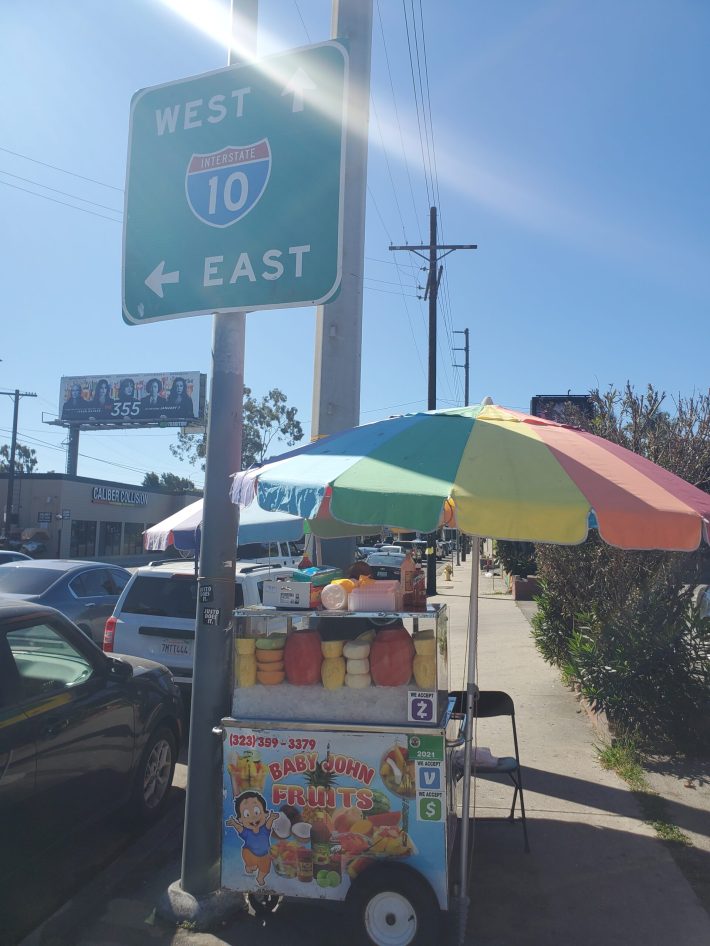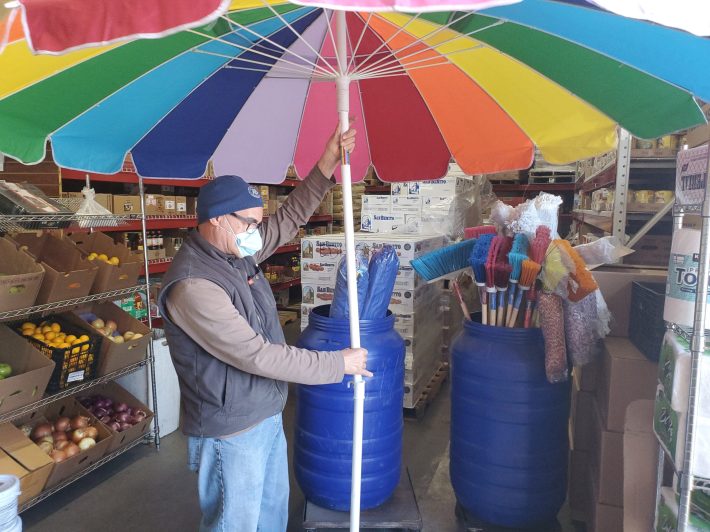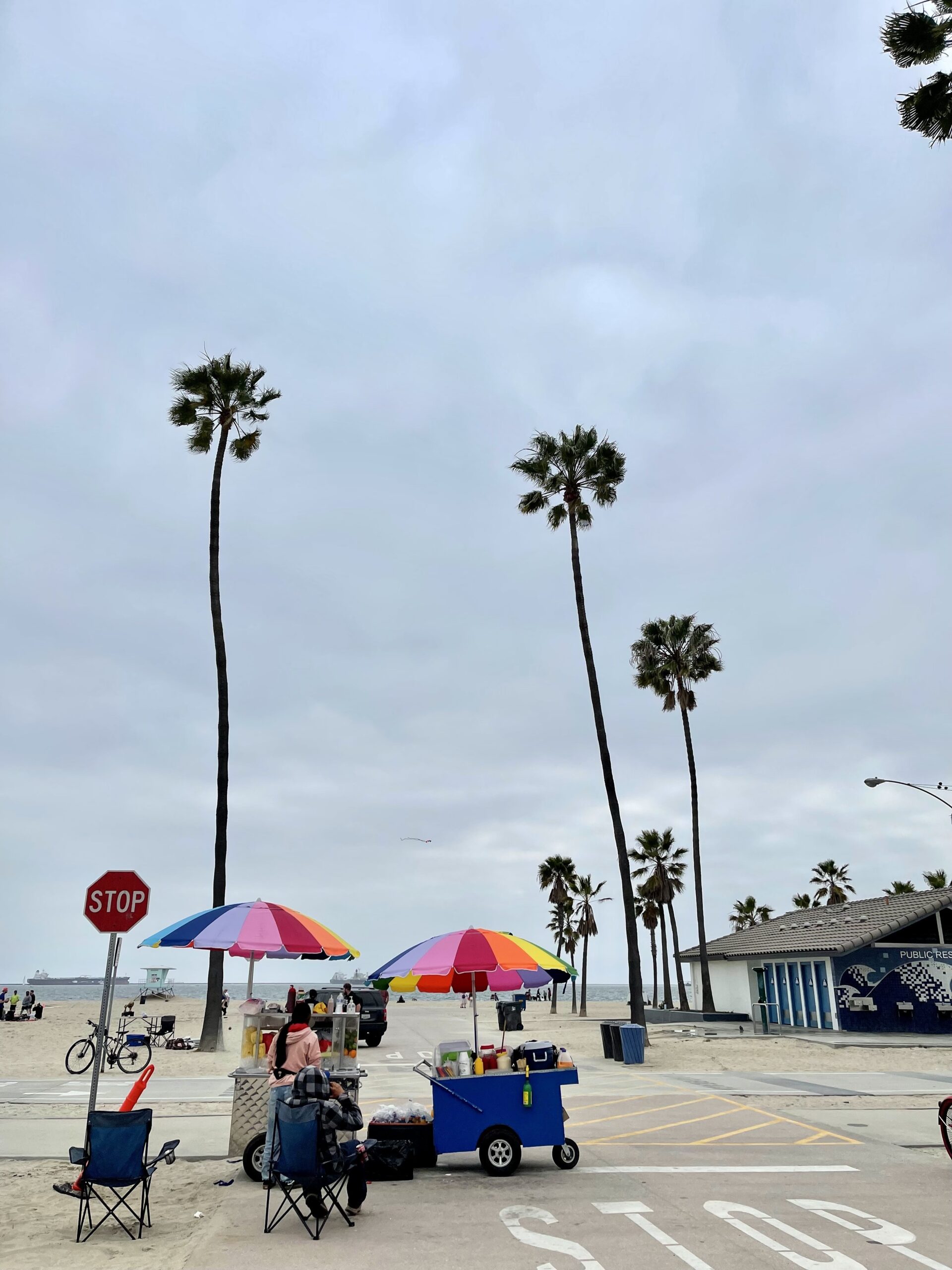I’m searching for information on the rainbow-colored umbrellas favored by Los Angeles fruteros but getting nowhere. At Home Depot, they’re not displayed among the epic coolers and grills. Anawalt Lumber carries only tasteful, earth-toned numbers. A few days ago, I even squeezed in under the canopy of a surprised fruit vendor near Hamilton High in hopes of finding a manufacturer’s tag. No such luck. Nor was there any other clue as to where the sunshade came from.
What’s with this self-imposed mission? I actually don’t have a patio, but I do feel a pang of guilt because I know so little about what I consider to be a civic symbol of L.A. In a few clicks, I can learn everything there is to know about the tulips of Amsterdam or the hot dogs of Chicago. But there’s no wiki page for the sun-bleached parasols that dot this city.
To me, these umbrellas do far more than block the sun. They represent L.A. and its gorgeous, gritty soul. Clamped to a vendor’s cart, they announce that here, on this spot, at this corner, there’s freshly cut fruit jacked with salt and chile lime powder.
As I watch skilled hands slice the ripe produce, I feel close to the best of the city. The conversations are upbeat, usually about customizing an order—light on the jicama for me, thank you. The prep techniques vary slightly: Some vendors season the fruit directly on the cutting board; others layer the spices as they scoop everything up.
Alongside a freeway entrance or nestled near a busy bus stop, a frutero’s umbrella symbolizes the long hours vendors spend on their feet, toiling outdoors under an unforgiving sun, rolling with the ebb and flow of passers-by—the ones who always stop and the ones who never do—and putting up with everything else it takes just to serve up the pleasure that is a cup of freshly squeezed, lime juice-sluiced watermelon on a hot day.
Which is why knowing zilch about the umbrellas bothers me. And why, when I finally enter Gomez Produce and Dairy on the fringe of downtown’s wholesale produce market and spot them, wrapped and standing in a barrel, I’m almost giddy. Here is where fruteros stock up on their work tools—plastic forks, towers of cups, oversize bottles of chamoy and, yes, those umbrellas.


Within minutes, I’m buttonholing one of the store assistants, David, a native of Torreón, Coahuila. The price? $55. And where are the umbrellas from? “La verdad,” he says, hazarding a guess, “todo viene de China.” He opens one umbrella. Again, no tag. Then a coworker calls out from the back, where the shipping boxes are stacked. “China,” he confirms. I rush over to verify what’s stamped on the cardboard: Beach Umbrella with Fabric Carry Bag. Color: 8 Color. Made in China. Bingo!
Well, kind of.
My umbrella quest was prompted by a nagging sense that there are fewer fruteros around. It’s been a while since I’ve seen the guy at the edge of the Target parking lot who always had the sweetest papaya, and, come to think of it, I rarely spy the lady by the gas station on El Segundo Boulevard who stacked the fruit extra high. To find out if my hunch is right, I contact Rocío Rosales, associate professor of sociology at UC Irvine and the author of Fruteros: Street Vending, Illegality, and Ethnic Community in Los Angeles (University of California Press, 2020), a fascinating study that highlights the paisanaje—many fruteros share common hometowns and send money back to their families—and the evolving challenges of selling fruit in a public space.
“The farther east I got from Westwood, the more at home I felt,” she tells me.
Rosales’s research started when, shortly after earning her undergraduate degree at Princeton, the El Paso, Texas, native arrived in Los Angeles to pursue her doctoral degree at UCLA. “The farther east I got from Westwood, the more at home I felt,” she tells me. On one of her crosstown bus commutes, she got off near Crenshaw and Wilshire and chatted with a frutero. So began six years of fieldwork that led her to commissaries, backyards, and, with the encouragement of Carmen, one of the principal subjects of Rosales’s book, donning a fruit seller’s apron for two summers and running a cart.
For the record, Rosales takes her fruit without salt—“There’s enough in the Tajín”—and prefers pineapple, watermelon, and cucumber. Her knowledge of fruteros is exhaustive and extends from the choice of locations– a constant balance between the reward of foot traffic and the risk of running afoul of permit enforcement– to the ambiguous effect that remittance payments have on distant hometowns. (She traveled to tiny Dos Mundos, Puebla, in the course of her research.)

When I ask straight up if there are indeed fewer vendors these days, Rosales is clear in her assessment. “Whoever wasn’t hit by COVID, was hit by declining sales,” she says, noting that pedestrian customers disappeared during the pandemic and, with them, the underpinnings of the “immigrant entrepreneurship” she highlights in her book. Carmen, for example, had built a business of five carts at five different corners. “She is down to one corner and one cart, which she works herself.”
Her answer makes me think that there are two things fruteros need to recover. The first is support from those of us who patronize vendors, extending beyond the purchase of the occasional fruit cup. “We all need to collectively agree that street vending should be legal,” says Rosales, who still counts many friends in the frutero community. Which reminds me that 2018’s Safe Sidewalk Vending Act did indeed reduce the punitive measures that can be taken against vendors, but full compliance still requires that carts include costly multiple sinks and that vendors sell only precut fruit. Could anything be worse for business?
What is a civic symbol? It’s the best of a place captured in resonant visual form. It can be a Dodger cap worn with pride. It can be dusk glowing on the San Gabriel Mountains. And it can be a colorful umbrella fluttering in the breeze.
But along with some more reasonable legal measures, we all need to understand that fruteros stand for something authentic, soulful, and increasingly important to preserve as the city evolves. After all, a non-permitted business has always depended on a communal recognition of the right to enterprise.
In his book Sidewalk (Farrar, Straus and Giroux, 1999), a pavement-level examination of used-magazine vendors of New York’s Greenwich Village, sociologist Mitchell Duneier employs the term “sustaining habitat” to describe the conditions necessary for commercial activity where it’s not officially sanctioned. Key to it is a flow of people who will purchase something. In Duneier’s study, it’s business-improvement groups and real estate concerns that have a different vision, not to mention the municipal code on their side.
In L.A., the conversation must be about how the two points of view can coexist. You need only look around our neighborhoods to see a loss of “sustaining habitat” as mixed-use retail projects and glass-skinned condos take over formerly ragged city blocks. Shiny and landscaped, these new buildings are guarded, patrolled, and secured. Not an environment a frutero who has just invested in another day’s fresh produce would want to pay a raitero (person who transports the fruit cart) to deliver a loaded cart to.
Los Angeles has traditionally allowed fruteros to exist at the edge of legal spaces, and even—respect them—on the steps of downtown’s L.A. County Superior Court, so that, altogether, they represent part of the essence of the city. Their umbrellas reflect the refreshing palette of the fruits on offer. Wait in line, and you’ll enjoy a little fellowship as the tender coconuts and oranges are roughly chopped while the city compresses around you in a genial embrace.
What is a civic symbol? It’s the best of a place captured in resonant visual form. It can be a Dodger cap worn with pride. It can be dusk glowing on the San Gabriel Mountains. And it can be a colorful umbrella fluttering in the breeze.
Just last week, I glimpsed one I hadn’t seen before on a stretch of Imperial Highway along the southern edge of LAX. The umbrella did exactly what it was supposed to do: It caught my eye. I was hungry, and the fruit looked beautiful. I had to stop.







